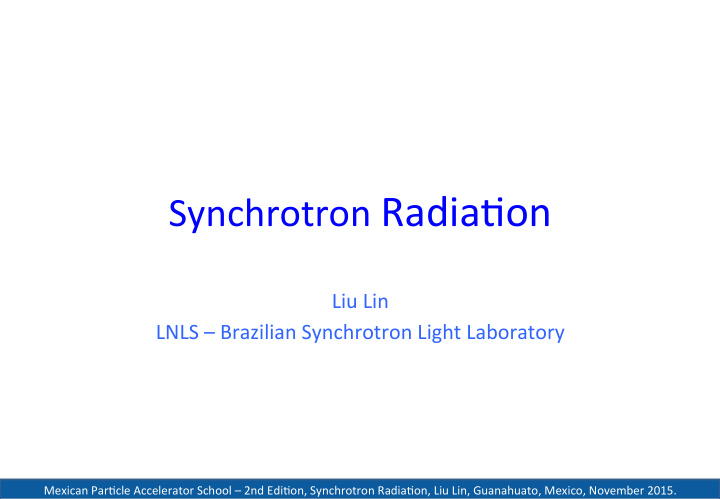



Synchrotron ¡ Radia+on ¡ Liu ¡Lin ¡ LNLS ¡– ¡Brazilian ¡Synchrotron ¡Light ¡Laboratory ¡ Mexican ¡Par+cle ¡Accelerator ¡School ¡– ¡2nd ¡Edi+on, ¡Synchrotron ¡Radia+on, ¡Liu ¡Lin, ¡Guanahuato, ¡Mexico, ¡November ¡2015. ¡
Observa+on ¡tools ¡– ¡origins ¡of ¡modern ¡science ¡ Galileo Galilei 1564-1642 Robert Hooke 1638-1703 Antonie van Leeuwenhoek 1632-1723 Mexican ¡Par+cle ¡Accelerator ¡School ¡– ¡2nd ¡Edi+on, ¡Synchrotron ¡Radia+on, ¡Liu ¡Lin, ¡Guanahuato, ¡Mexico, ¡November ¡2015. ¡
Robert ¡Hook ¡ 1665 ¡ Mexican ¡Par+cle ¡Accelerator ¡School ¡– ¡2nd ¡Edi+on, ¡Synchrotron ¡Radia+on, ¡Liu ¡Lin, ¡Guanahuato, ¡Mexico, ¡November ¡2015. ¡
Robert ¡Hook ¡ 1665 ¡ Mexican ¡Par+cle ¡Accelerator ¡School ¡– ¡2nd ¡Edi+on, ¡Synchrotron ¡Radia+on, ¡Liu ¡Lin, ¡Guanahuato, ¡Mexico, ¡November ¡2015. ¡
And ¡if ¡we ¡want ¡to ¡know ¡the ¡atomic ¡structure? ¡ Mexican ¡Par+cle ¡Accelerator ¡School ¡– ¡2nd ¡Edi+on, ¡Synchrotron ¡Radia+on, ¡Liu ¡Lin, ¡Guanahuato, ¡Mexico, ¡November ¡2015. ¡
-‑ ¡Ribossom ¡atomic ¡structure. ¡ -‑ ¡Besides ¡the ¡importance ¡as ¡fundamental ¡ knowledge, ¡important ¡for ¡the ¡development ¡ of ¡an+bio+cs. ¡ ¡ V. ¡Ramakrishnan; ¡T. ¡A. ¡Steitz; ¡Ada ¡E. ¡Yonath ¡ ¡ Prêmio ¡Nobel ¡de ¡Química ¡de ¡2009 ¡ THE ¡USE ¡OF ¡SYNCHROTRON ¡ RADIATION ¡WAS ¡FUNDAMENTAL ¡ FOR ¡THIS ¡RESEARCH! ¡ Mexican ¡Par+cle ¡Accelerator ¡School ¡– ¡2nd ¡Edi+on, ¡Synchrotron ¡Radia+on, ¡Liu ¡Lin, ¡Guanahuato, ¡Mexico, ¡November ¡2015. ¡
Electrodynamics: ¡ Historical ¡understanding ¡ Hans ¡Chris+an ¡Ørsted ¡(1777-‑1851) ¡ André-‑Marie ¡Ampère ¡(1775 ¡– ¡1836) ¡ ¡ • In ¡1820 ¡ Ø ersted ¡discovered ¡that ¡ electric ¡currents ¡create ¡magne3c ¡fields . ¡He ¡no+ced ¡that ¡a ¡ compass ¡needle ¡was ¡deflected ¡from ¡magne+c ¡north ¡when ¡an ¡electric ¡current ¡from ¡a ¡bajery ¡was ¡ switched ¡on ¡and ¡off. ¡The ¡electric ¡bajery ¡was ¡invented ¡in ¡1800 ¡by ¡Alessandro ¡Volta. ¡ • Ampère ¡was ¡fascinated ¡by ¡Oersted’s ¡discovery ¡and ¡decided ¡to ¡understand ¡why ¡electric ¡current ¡ produced ¡a ¡magne+c ¡field. ¡He ¡discovered ¡that ¡magne+c ¡ajrac+on ¡and ¡repulsion ¡is ¡produced ¡ between ¡two ¡parallel ¡wires ¡carrying ¡electric ¡currents. ¡ All ¡magne3sm ¡was ¡generated ¡electrically . ¡ Mexican ¡Par+cle ¡Accelerator ¡School ¡– ¡2nd ¡Edi+on, ¡Synchrotron ¡Radia+on, ¡Liu ¡Lin, ¡Guanahuato, ¡Mexico, ¡November ¡2015. ¡
Electrodynamics: ¡ Historical ¡understanding ¡ Michael ¡Faraday ¡(1791 ¡– ¡1867) ¡ ¡ • In ¡1831 ¡Faraday ¡discovered ¡that ¡a ¡varying ¡magne+c ¡field ¡causes ¡electricity ¡to ¡flow ¡in ¡an ¡ electric ¡circuit. ¡Previously, ¡people ¡had ¡only ¡been ¡able ¡to ¡produce ¡electric ¡current ¡with ¡a ¡ bajery. ¡Now ¡Faraday ¡had ¡shown ¡that ¡movement ¡could ¡be ¡turned ¡into ¡electricity. ¡ • Most ¡of ¡the ¡power ¡in ¡our ¡homes ¡today ¡is ¡produced ¡using ¡this ¡principle. ¡ Mexican ¡Par+cle ¡Accelerator ¡School ¡– ¡2nd ¡Edi+on, ¡Synchrotron ¡Radia+on, ¡Liu ¡Lin, ¡Guanahuato, ¡Mexico, ¡November ¡2015. ¡
Electrodynamics: ¡ Historical ¡understanding ¡ James ¡Clerk ¡Maxwell ¡(1831–1879) ¡ Gauss ¡Law ¡ Gauss ¡Law ¡for ¡Magne+sm ¡ Faraday ¡Law ¡ Ampere-‑Maxwell ¡Law ¡ • Maxwell ¡bla ¡blabla ¡bla ¡ • Maxwell’s ¡equa+ons ¡made ¡evident ¡that ¡changing ¡ charge ¡densi+es ¡would ¡result ¡in ¡electromagne+c ¡ waves ¡that ¡would ¡radiate ¡outward ¡with ¡the ¡ speed ¡iden+cal ¡to ¡the ¡speed ¡of ¡light. ¡ ¡ Mexican ¡Par+cle ¡Accelerator ¡School ¡– ¡2nd ¡Edi+on, ¡Synchrotron ¡Radia+on, ¡Liu ¡Lin, ¡Guanahuato, ¡Mexico, ¡November ¡2015. ¡
Electrodynamics: ¡ Historical ¡understanding ¡ Heinrich ¡Hertz ¡(1857 ¡– ¡1894) ¡ • In ¡1887 ¡Heinrich ¡Hertz ¡demonstrated ¡the ¡existence ¡of ¡such ¡waves ¡by ¡inducing ¡ extremely ¡small ¡sparks ¡in ¡a ¡resonant ¡antenna. ¡ When ¡asked ¡about ¡the ¡prac+cal ¡importance ¡of ¡his ¡experiments ¡he ¡replied: ¡“It's ¡of ¡no ¡ use ¡whatsoever, ¡this ¡is ¡just ¡an ¡experiment ¡that ¡proves ¡Maestro ¡Maxwell ¡was ¡right.” ¡ Asked ¡about ¡the ¡ramifica+ons ¡of ¡his ¡inven+ons ¡Hertz ¡replied: ¡"Nothing, ¡I ¡guess.” ¡ ¡ Mexican ¡Par+cle ¡Accelerator ¡School ¡– ¡2nd ¡Edi+on, ¡Synchrotron ¡Radia+on, ¡Liu ¡Lin, ¡Guanahuato, ¡Mexico, ¡November ¡2015. ¡
Electrodynamics: ¡ Historical ¡understanding ¡ Heinrich ¡Hertz ¡(1857 ¡– ¡1894) ¡ • In ¡1887 ¡Heinrich ¡Hertz ¡demonstrated ¡the ¡existence ¡of ¡such ¡waves ¡by ¡inducing ¡ extremely ¡small ¡sparks ¡in ¡a ¡resonant ¡antenna. ¡ • When ¡asked ¡about ¡the ¡prac+cal ¡importance ¡of ¡his ¡experiments ¡he ¡replied: ¡“It's ¡of ¡no ¡ use ¡whatsoever, ¡this ¡is ¡just ¡an ¡experiment ¡that ¡proves ¡Maestro ¡Maxwell ¡was ¡right.” ¡ Asked ¡about ¡the ¡ramifica+ons ¡of ¡his ¡inven+ons ¡Hertz ¡replied: ¡"Nothing, ¡I ¡guess.” ¡ ¡ Mexican ¡Par+cle ¡Accelerator ¡School ¡– ¡2nd ¡Edi+on, ¡Synchrotron ¡Radia+on, ¡Liu ¡Lin, ¡Guanahuato, ¡Mexico, ¡November ¡2015. ¡
Electrodynamics: ¡ Historical ¡understanding ¡ Albert ¡Einstein ¡(1879–1955) ¡ • In ¡1905 ¡Albert ¡Einstein ¡published ¡the ¡paper ¡founding ¡Special ¡Theory ¡of ¡Rela+vity, ¡in ¡ which ¡he ¡proposed ¡that ¡light ¡is ¡always ¡propagated ¡in ¡empty ¡space ¡with ¡a ¡definite ¡ velocity ¡ c ¡which ¡is ¡independent ¡of ¡the ¡state ¡of ¡mo+on ¡of ¡the ¡emivng ¡body. ¡It ¡then ¡ follows ¡that ¡+me, ¡length ¡and ¡mass ¡actually ¡depend ¡on ¡the ¡speed ¡we ¡are ¡moving ¡at. ¡For ¡ example, ¡as ¡we ¡move ¡faster, ¡+me ¡passes ¡more ¡slowly ¡and ¡lengths ¡become ¡contracted. ¡ • Transforma+ons ¡between ¡reference ¡frames ¡follow ¡Lorentz ¡Transforma+on, ¡that ¡ preserve ¡the ¡symmetries ¡of ¡the ¡laws ¡of ¡electromagne+sm. ¡ ¡ Mexican ¡Par+cle ¡Accelerator ¡School ¡– ¡2nd ¡Edi+on, ¡Synchrotron ¡Radia+on, ¡Liu ¡Lin, ¡Guanahuato, ¡Mexico, ¡November ¡2015. ¡
Synchrotron ¡Radia+on ¡ • Accelerator-‑based ¡synchrotron ¡radia+on ¡was ¡first ¡observed ¡at ¡GE ¡in ¡1947 ¡in ¡ a ¡type ¡of ¡accelerator ¡known ¡as ¡synchrotron. ¡Since ¡then, ¡the ¡ electromagne+c ¡radia+on ¡generated ¡in ¡these ¡machines ¡is ¡called ¡ synchrotron ¡radia+on. ¡ • We ¡now ¡use ¡the ¡name ¡synchrotron ¡radia+on ¡(light) ¡to ¡describe ¡radia+on ¡ that ¡is ¡emijed ¡from ¡charged ¡par+cles ¡traveling ¡at ¡rela+vis+c ¡speeds ¡( v≈c ) ¡ when ¡they ¡change ¡direc+on, ¡regardless ¡of ¡the ¡accelera+ng ¡mechanism ¡and ¡ shape ¡of ¡the ¡trajectory. ¡ • Although ¡synchrotron ¡radia+on ¡can ¡cover ¡the ¡en+re ¡ electromagne+c ¡spectrum, ¡we ¡are ¡interested ¡in ¡ radia+on ¡in ¡the ¡UV, ¡sow ¡and ¡hard-‑X ¡ray ¡regimes. ¡ Mexican ¡Par+cle ¡Accelerator ¡School ¡– ¡2nd ¡Edi+on, ¡Synchrotron ¡Radia+on, ¡Liu ¡Lin, ¡Guanahuato, ¡Mexico, ¡November ¡2015. ¡
The ¡electromagne+c ¡spectrum ¡ accelerator ¡ ¡ based ¡sources ¡ Mexican ¡Par+cle ¡Accelerator ¡School ¡– ¡2nd ¡Edi+on, ¡Synchrotron ¡Radia+on, ¡Liu ¡Lin, ¡Guanahuato, ¡Mexico, ¡November ¡2015. ¡
The ¡atomic ¡scale: ¡X-‑Rays ¡ H. ¡Wiedemann ¡ Mexican ¡Par+cle ¡Accelerator ¡School ¡– ¡2nd ¡Edi+on, ¡Synchrotron ¡Radia+on, ¡Liu ¡Lin, ¡Guanahuato, ¡Mexico, ¡November ¡2015. ¡
Recommend
More recommend